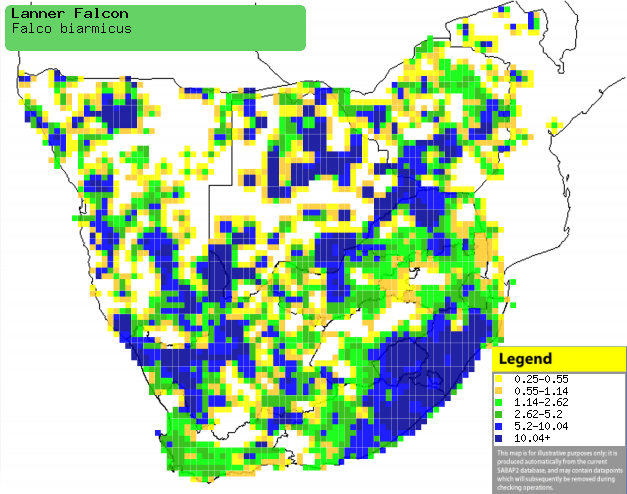|
Falco biarmicus (Lanner falcon)
Edelvalk [Afrikaans]; Ukhetshe (also applied to Peregrine
falcon) [Xhosa]; uHeshe (also applied to Perigrine falcon) [Zulu]; Kakodi
(generic term for sparrowhawks, goshawks, kestrels and falcons) [Kwangali];
Phakoe (also applied to Eurasian hobby) [South Sotho]; Pekwa [North Sotho];
Rukodzi (generic name for a small raptor such as falcon or sparrowhawk) [Shona];
Rikhozi (generic term for some raptors) [Tsonga]; Phakwę (generic term for some
of the smaller raptors) [Tswana]; Lannervalk [Dutch]; Faucon lanier [French];
Lannerfalke [German]; Falcăo-alfaneque [Portuguese]
Life
> Eukaryotes >
Opisthokonta
> Metazoa (animals) >
Bilateria >
Deuterostomia > Chordata >
Craniata > Vertebrata (vertebrates) > Gnathostomata (jawed
vertebrates) > Teleostomi (teleost fish) > Osteichthyes (bony fish) > Class:
Sarcopterygii (lobe-finned
fish) > Stegocephalia (terrestrial
vertebrates) > Tetrapoda
(four-legged vertebrates) > Reptiliomorpha > Amniota >
Reptilia (reptiles) >
Romeriida > Diapsida > Archosauromorpha > Archosauria >
Dinosauria
(dinosaurs) > Saurischia > Theropoda (bipedal predatory dinosaurs) >
Coelurosauria > Maniraptora > Aves
(birds) > Order: Falconiformes >
Family: Falconidae
Distribution and habitat
Occurs in southern and south-eastern Europe, the Middle
East, south-western Asia and much of sub-Saharan Africa, excluding the lowland
forests of the DRC and West Africa. In southern Africa it is fairly common across the region, largely
excluding Mozambique. It generally favours open grassland, cleared or open
woodland and agricultural land. While breeding it is most common around cliffs
used as nesting and roost sites, although it may also use buildings, electricity
pylons and trees.
|
 |
|
Distribution of Lanner falcon in southern Africa,
based on statistical smoothing of the records from first SA Bird Atlas
Project (©
Animal Demography unit, University of
Cape Town; smoothing by Birgit Erni and Francesca Little). Colours range
from dark blue (most common) through to yellow (least common).
See here for the latest distribution
from the SABAP2. |
Predators and parasites
It has been recorded as prey of
Bubo
capensis (Cape eagle-owl).
Movements and migrations
Partial migrant in southern Africa, as many
juveniles depart from their breeding grounds around December-January
in the eastern grasslands of South Africa, heading west and south-west to the
Kalahari, Karoo and the Western Cape.
Food
It eats mainly birds, especially doves, pigeons and
chickens, hunting using extreme speed to
surprise its prey. It often hunts from a high perch or while soaring high up in
the air, making a steep and rapid dive to intercept a bird either aerially or on
the ground. It often hunts in pairs (see photo below), enabling them to catch large or highly illusive prey. The following food items have been recorded
in its diet:
- Animals
- birds
- small mammals
- reptiles
- insects
Breeding
- Monogamous territorial solitary nester, probably with a long pair bond,
although a nest was once recorded to have two males and one female attending it,
suggesting polyandry.
- The nest is typically a simple scrape in sand or soil on a cliff ledge
or is placed in another structure such as a building or nest box. It may also use the
stick nest of another bird such as a
White-necked raven,
Verreaux's eagle or
Bateleur, sometimes
displacing them while they are breeding and possibly killing their chicks in
the process. As these stick nests are often on utility pylons and poles,
Lanner falcons have been able to colonise treeless areas where they have
not previously occurred.
- Egg-laying season is from late May to early September.
- It lays 1-5 eggs, which are incubated mainly by the female for about 32
days, starting with the egg laid last or second last.
- The chicks are brooded constantly by the female for the first few days
of their lives, after which they are brooded intermittently for about 1-2
weeks. Even then the female still remains close to the nest, relying on the
male to do most of the hunting. The young eventually leave the nest at 42-45
days old, becoming fully independent about 1-3 months later.
Threats
Not threatened globally but Near-threatened in South
Africa, due to local extinctions possibly caused by a vulnerability to
agrochemicals. It has however benefited from the clearing of savanna and the
increasing availability of free-range poultry.
References
-
Hockey PAR, Dean WRJ and Ryan PG 2005. Roberts
- irBds of southern Africa, VIIth ed. The Trustees of the John Voelcker
Bird Book Fund, Cape Town.
|
